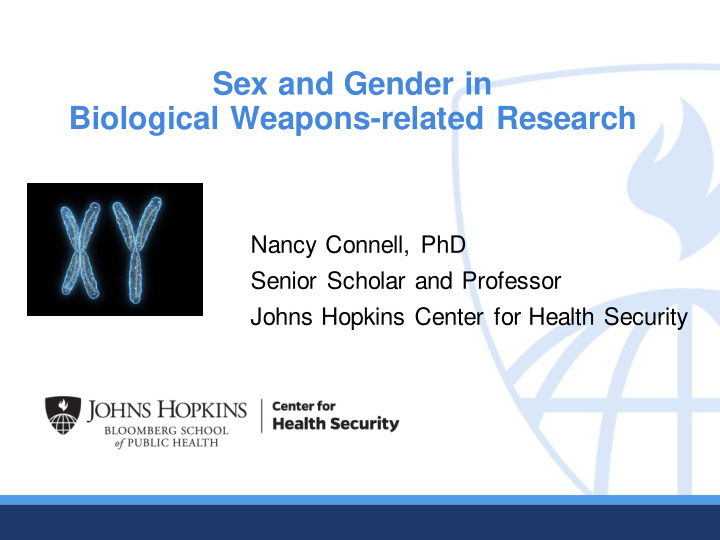



Sex and Gender in Biological Weapons-related Research Nancy Connell, PhD Senior Scholar and Professor Johns Hopkins Center for Health Security
• Some definitions • Sex differences in medical research • Misconceptions about sex in research • Sex and the immune response • Sex and vaccines • Sex and susceptibility to infectious disease • What next? 2
Some definitions… “Sex” is a biological variable referring to differences defined by sex chromosomes (XX, XY) and the presence of functional reproductive organs. “Gender” is a cultural construct referring to behaviors thought to be specified by psychosocial expectations that accrue on the basis of perceived or assigned sex. As our understanding develops regarding epigenetic modification of the genome by the environment, age, and hormonal status, it is evident that sex and gender are a composite. Miller et al., Biology of Sex Differences 2016, 7(Suppl 1):44 3
History of recognition of the role of sex in medical research • 1977 - FDA excludes women of child-bearing age from drug trials • 1980s – concern arise that clinical research (NIH) on conditions that affect both men and women were being carried out only on white males but results were being applied to all men and women of all races. • 1990s – Congresswomen, FDA and NIH return women to clinical trials (but still no disaggregation) • 2002- GAO determines that 8 of 10 drugs taken off the market (1997-2000) had adverse effects on women • 2010 -the Canadian Institutes of Health required the discussion of the inclusion of sex or gender in both non-human animals and humans in grant applications • 2015 – GAO determined still no differentiation • 2016 – NIH finally links changes to funding • 2020 - European Union Strategic Vision for Gender 4
Sex in medical research • “Women do not benefit from medical research as much as men do. This problem stems both from research design (which scientists largely control), and from scientific reporting in journals (which editors can influence)”. Leopold et al., Clin Orthop Relat Res (2014) 472:391 5
Misconceptions about sex of animals* in research • No real difference between males and females • Females more variable due to estrous cycle • Unstaged female mice, rats, and hamsters (i.e., those not monitored for estrous cycle stage) are no more variable than males in surveys of hundreds of physiological traits and behaviors. • Disaggregation of sex does not apply to other living organisms that can be classified by sex *including humans Neurosci Biobehav Rev 2014;40:1; Biol Sex Differ 2015;6:18; Biol Sex Differ 2016;7:3; Hypertension 2016;68: 1139. 6
7
“In the area of infectious diseases of poverty, the dearth of women scientists often means a lack of diverse perspectives essential to addressing gender dimensions and the burden of infectious diseases, which often disproportionately affect women”. 8
Sex and immune response • In humans, it is evident that females have increased resistance against microbial infections, which suggests that females have a more vigorous immune de- fence against most invading pathogens. • Females also have higher antibody responses and more adverse re- actions in response to a number of vaccines • Estrogen acts as an immune activator while testosterone acts as an immune suppressor Schurz et al. Human Genomics (2019) 13:2 9
Klein and Flanagan 2016 10
Sex and vaccines • Variation in vaccine-induced immunity points to the critical impact of genetics, the environment, nutrition, the microbiome, and sex in influencing vaccine responsiveness. • Specifically, females typically develop higher antibody responses and experience more adverse events following vaccination than males. • This enhanced immune reactogenicity among females is thought to render females more resistant to infectious diseases. • Dissection of mechanisms which underlie sex differences in vaccine-induced immunity has implicated hormonal, genetic, and microbiota differences across males and females Fischinger et al.,Seminars in Immunopathology (2019) 41:239 – 249 11
Fischinger et al.,Seminars in Immunopathology (2019) 41:239 – 249 12
13
Sex and diseases
Key components of the immune response are carried on the sex chromosomes • The X chromosome is known to contain the largest number of immune-related genes of the whole human genome. • X chromosome, X-linked genes and X chromosome inactivation mechanisms contribute to the clear sex bias of many diseases, including infections. 15
Conclusions – how will these early studies be applied in the BWC context? Susceptibility • Males and females exhibit contrasting degrees of susceptibility to infectious and non-infectious inflammatory diseases. • This is particularly observed in respiratory diseases where human males are more likely to be affected by infection-induced acute inflammations compared to females. 16
Conclusions – how will these early studies be applied in the BWC context? Vaccines: • Sex profoundly affects the immune response and can therefor affect outcomes of vaccination. • Few studies stratify data in terms of sex. • Currently, most vaccines are tailored based on a male-dominated participant pool and the same set of vaccines is administered to everyone. • The effects of sex and pregnancy should be considered in all guidelines and recommendations for vaccines and represent an opportunity for researchers and public health officials to better understand and explain individual variability in vaccine efficacy. • Sex-specific vaccine strategies may provide enhanced protection for females. 17
“Every cell is sexed… quora.com …and every person is gendered. 1 ” mfoundation.org 1 Institute of Gender and Health, Canadian Institutes of Health Research 18
Recommend
More recommend